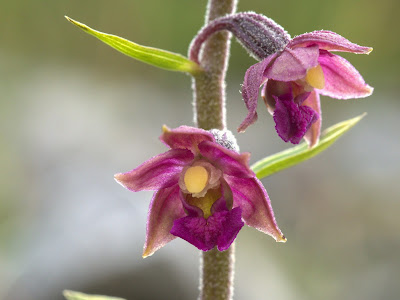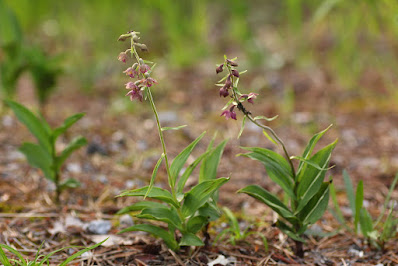Epipactis atrorubens, also called as Dark-red helleborine, Royal helleborine is found growing in loose rock, scree, or sandy soils above a limestone..
Epipactis atrorubens, also called as Dark-red helleborine, Royal helleborine, Amesia atropurpurea, Amesia rubiginosa, Epipactis atropurpurea, Epipactis cruenta, Epipactis danubialis, Epipactis helleborine var. rubiginosa, Epipactis helleborine var. viridans, Epipactis macropodia, Epipactis media, Epipactis microphylla, Epipactis persica subsp. danubialis, Epipactis spiridonovii, Epipactis subclausa, Epipactis thessala, Helleborine atropurpurea, Helleborine atrorubens, Helleborine media, Helleborine rubiginosa, Helleborine viridans, Limodorum rubiginosum, Serapias atrorubens, Serapias latifolia, Serapias latifolia atrorubens, Serapias sylvestris, is a species of the genus Epipactis. This species was described by Wilibald Swibert Joseph Gottlieb von Besser in 1809.
IDENTIFY EPIPACTIS ATRORUBENS - DARK-RED HELLEBORINE - ROYAL HELLEBORINE
Epipactis atrorubens is native to Europe to Caucasus. It is found growing in loose rock, scree, or sandy soils above a limestone substrate, including dunes, lawns, or open forest of Albania, Austria, Baltic States, Belarus, Belgium, Bulgaria, Central European Rus, Czechoslovakia, Denmark, East European Russia, Finland, France, Germany, Great Britain, Greece, Hungary, Ireland, Italy, Netherlands, North Caucasus, North European Russi, Northwest European R, Norway, Poland, Romania, South European Russi, Spain, Sweden, Switzerland, Transcaucasus, Turkey-in-Europe, Ukraine, West Siberia, Yugoslavia at elevations of 0-2400 meters above sea level.
Dark-red helleborine is a large sized, cool to cold growing terrestrial species which reaching 20-100 cm in height with short rhizome and sparsely hairy stem. The leaves are 3-10, orbiculate, elliptic, or narrowly lanceolate, 4-10 × 1.5-4.5 cm, distinctive and grow on either of the side of the stem almost in opposite facing pairs. They are deeply ridged and heavily veined, but leaves higher up the stem are longer and narrower.
Royal helleborine blooms in late spring and summer from the terminal, pubescent, 7 to 25 cm long, densely 8-18-flowered inflorescence. The small flowers are dark wine to cranberry red and have a strong vanilla scent, especially in warm weather.; sepals dark wine red, rarely dull rose or greenish; lip indistinctly veined, constricted at middle into 2 parts, proximal part greenish with red edges, adaxial surface spotted with violet-red or brown, distal part brighter and darker; calli brownish, brighter, darker in color than lip;anther yellow; pollinia yellow.
EPIPACTIS ATRORUBENS - DARK-RED HELLEBORINE - ROYAL HELLEBORINE CARE AND CULTURE
Cultural information should only be used as a guide, and should be to be adapted to suit you. Your physical location; where you grow your plants, how much time you have to devote to their care, and many other factors, will need to be taken into account. Only then can you decide on the cultural methods that best suit you and your plants.
Light:
Epipactis atrorubens are best positioned in an area that attracts partial sunlight as they will thrive better in shady spaces. These plants can be planted in full sunlight on condition that the substrate is prevented from becoming dry in summer.
Humidity:
Dark-red helleborine needs the humidity level of 40-70%. Too dry air has a negative effect on the development of the plant: its growth is inhibited, and the leaves begin to turn yellow and dry out. The higher temperature, the higher the humidity should be, and the higher the humidity, the more often and longer it is necessary to ventilate the room where the plants are contained, otherwise the probability of rotting and various kinds of fungal diseases.
If the humidity levels are consistently too low, consider buying a humidifier to increase the humidity level. Another way of increasing humidity is by setting your plants on trays filled with pebbles or gravel and with water, but plants should not be in contact with the water.
Temperature:
Royal helleborine grow best at summer days average of 22-25 °C, and nights average 17-19 °C, with a diurnal range of 5- 8°C. Winter days average 14-16 °C, and nights average 9-11 °C, with a diurnal range of 5-7 °C.
Substrate and growing media:
Epipactis atrorubens tolerate many conditions as long as pH is neutral, between 5.5 and 7 . They are best planted in moist well-drained soil of clay, chalk or loam within an acidic, alkaline or neutral PH balance. At the time of planting you may wish to supplement native soil with a generous amount of compost to maintain good moisture levels in the summer and to promote better drainage during the winter. You can use many media such as pumice gravel, coarse sand , loam and clay (max 5 %) , peat, fen soil , sphagnum , coco peat, oyster shells . Organics preferable less than 20 %.
Repotting is done once in two to three years in autumn, winter and spring when still dormant, or in late spring when growths have reached maturity.
Watering:
Dark-red helleborine require consistently moist soil to thrive and so therefore it is vital to water plants regularly throughout active growth and during prolonged periods of dry weather. Do not let your plants dry out at any time of the year, even during autumn and winter. Soil may not be too wet in full summer, risk of anaerobic soils. Warm compost with standing water is very dangerous! Rainwater is advisable, otherwise good quality tap water chlorine poor. Good oxygen rich water is essential.
Watering is directly dependent on the temperature of the content, the higher it is, the more often it needs to be watered. When watering, excess water should flow freely from the pot, since stagnation of water both inside the pot and in its pan can very quickly lead to rotting of the roots and the lower part of the plant.
Fertilizer:
Royal helleborine is an easy strong growing orchid, that needs more fertiliser as other species, so one may use a good quality chemical fertiliser in growing phase, dissolved in the water as a surplus. As basic fertiliser you can use slow release grains once a year, 10 grains per mature plant in spring when shoots break through the surface.
Rest period:
During the winter, Epipactis atrorubens persists in rhizome form and develops new shoots in the spring. They are the very cold-resistant and do not require any special protection in winter. It is possible to propagate by seed or by division once the plants are well-established. Highly proliferative, these orchids will quickly form colonies of several hundred head following the successive growth and dormancy cycles.















COMMENTS